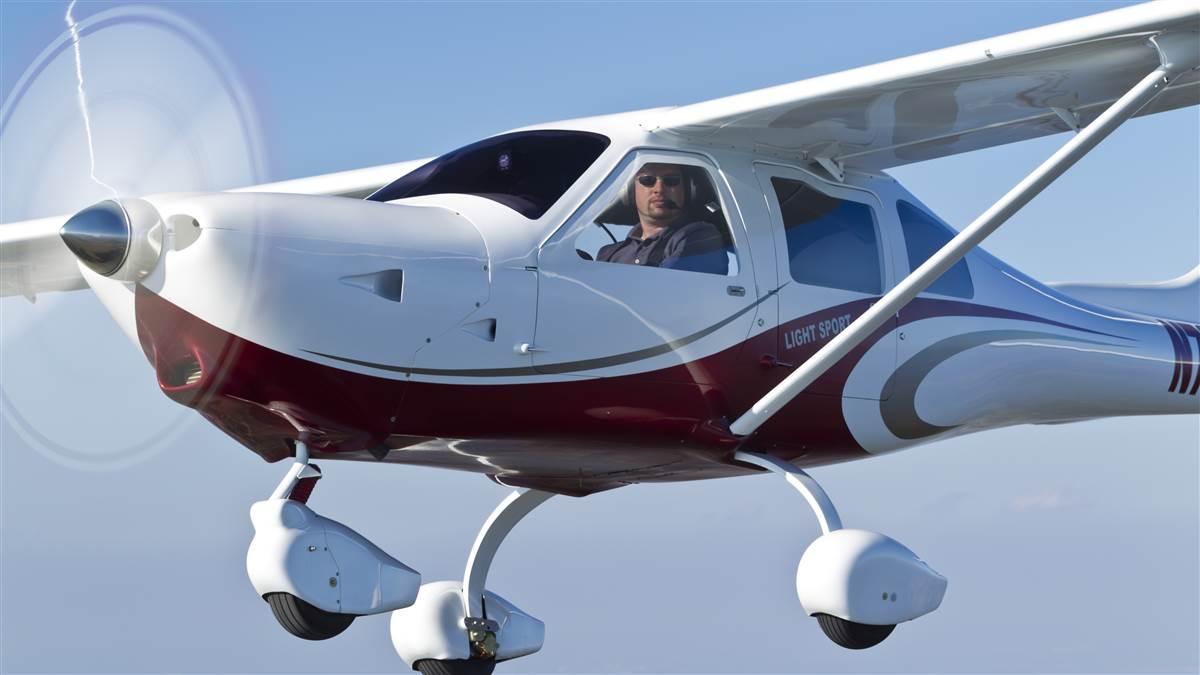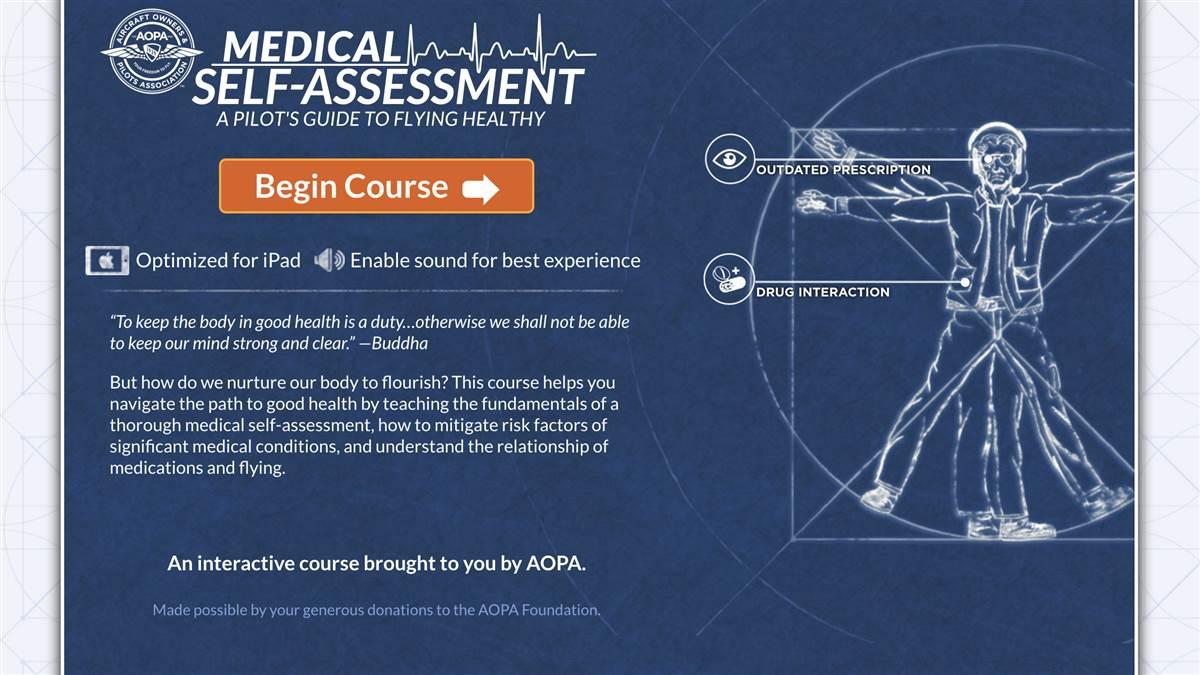
ASI News
Are you fit to fly?
Take stock of your body, your safety
By Machteld Smith
May 1, 2018, marks the anniversary of third class medical reform—known as BasicMed. This alternative to third class medical certification is an option for pilots who don’t fly for hire and who don’t want to go through the time and expense of the third class medical. But you don’t have to be a participant in BasicMed to start the journey to good health and flying safely with the free medical self-assessment online course developed by the AOPA Air Safety Institute. Medical Self-Assessment: A Pilot’s Guide to Flying Healthy is a great tool for all pilots—just ask the more than 30,000 pilots who’ve taken it.
 The course suggests getting a medical checkup regularly. It also offers thoughts on how to stay healthy, how to detect signs of adverse medical conditions, and what to do should you discover a situation that requires medical attention.
The course suggests getting a medical checkup regularly. It also offers thoughts on how to stay healthy, how to detect signs of adverse medical conditions, and what to do should you discover a situation that requires medical attention.
While not a replacement for professional medical advice from your physician, the course reviews how you can objectively evaluate your condition to fly. You’ll also learn about the complex relationship of medications and flying. Did you know that the FAA wants you to wait for at least five times the maximum pharmacologic half-life of the medication or, if that information is not available, wait for at least five maximum dosing intervals to have passed before flying? Or that drugs with no apparent side effect on the ground can create serious problems at even relatively low altitudes? Some over-the-counter medications may also effectively ground you—any medication that warns of possible impairment and to not operate motor vehicles or machinery while taking the drug is grounds for not flying.
If you have concerns about managing in-flight physiological impairment, there’s a chapter on that. But not just on what to do when there is a problem—you’ll learn what you can do to prevent problems from arising in the first place.
Review the medical self-assessment course periodically, and download the preflight and in-flight self-assessment checklists to take along in your flight bag.
Machteld Smith is an aviation technical writer for the AOPA Air Safety Institute.
NEW FROM ASI:
Troubled to talk to ATC?
It’s not unusual to feel intimidated keying the mic to contact air traffic control, especially when controllers are busy handling a lot of traffic. You might even be concerned that they will be inconvenienced to talk to a simple VFR flight squawking 1200. In Ask ATC: Bothering ATC, the AOPA Air Safety Institute discusses this issue with an air traffic controller. Her response may surprise you. Watch the video and share it with others.
Industry News
GA forecast has bright spots
Light Sport, drone markets expected to grow
By Jim Moore
The FAA expects general aviation to remain “stable” by most measures in the coming decades but uses different adjectives when estimating the growth of unmanned aircraft—particularly commercial drones flown under Part 107, for which even the conservative estimate calls for a fourfold increase in five years. An expected doubling of the size of the Light Sport aircraft fleet over the coming two decades is among the bright spots for GA in the latest annual update of long-term projections of all types of aviation activity. The forecast is based on data from many sources, including the FAA’s own, as well as other sources including General Aviation Manufacturers Association shipment and billing data. The agency also consults with a broad range of industry experts.
The active general aviation fleet is projected to remain around its current level, with the declines in the fixed-wing piston fleet being offset by increases in the turbine, Experimental, and Light Sport fleets, the agency said. “The total active general aviation fleet changes from an estimated 213,050 in 2017 to 214,090 aircraft by 2038.” While the GA fleet size will be little changed overall, the agency expects the piston segment to decline by 22,350 aircraft by 2038.
“Unfavorable pilot demographics, overall increasing cost of aircraft ownership, coupled with new aircraft deliveries not keeping pace with retirements of the aging fleet are the drivers of the decline,” the agency said. “On the other hand, the smallest category, Light Sport aircraft (created in 2005), is forecast to grow by 3.6 percent annually, adding about 2,850 new aircraft by 2038, more than doubling its 2016 fleet size.”
The latest forecast marks the second year the FAA has predicted unmanned aircraft activity, and that document reads much like the first, still calling for dramatic growth in the population of remote pilots certificated under Part 107, along with unmanned aircraft registered to operate under Part 107, with roughly fourfold increases for both projected—not in 20 years, but in five.
NEWS
How do you brief?
End of DUATS program leaves plenty of options
If you use CSRA DUATS, you’ll need to change the way you get online weather briefings by May 16. The end of the FAA’s Direct User Access Terminal Service (DUATS II) Program will affect any pilots who use CSRA for weather briefings and to file flight plans—either online or through a connected app. Pilots will still be able to access internet-based services including weather and aeronautical information, flight plan filing, and automated services at no charge at the flight service website (www.1800wxbrief.com). The online pilot portal from Leidos offers graphical briefings with maps of temporary flight restrictions, airmets and sigmets, and other weather maps, plus such convenient features as one-click EasyActivate and EasyClose for flight plans and Adverse Condition Alerting Service.
Ways to get a weather briefing
- Call 1-800-WX-BRIEF to speak to a briefer.
- Get a graphical briefing through the Leidos flight service web portal (www.1800wxbrief.com).
- Brief through a connected web service or app. The AOPA Flight Planner (www.aopa.org/flightplanner) offers a free preflight briefing service through Leidos. Additionally, several popular electronic flight bag apps offer briefings; check with your app to see how the DUATS change affects you.
